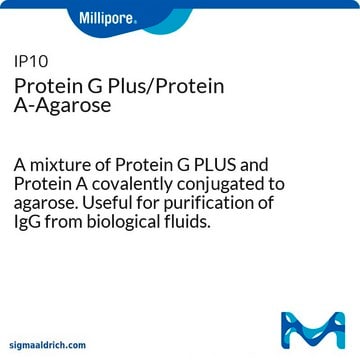16-266
Protein G Agarose, Fast Flow
Protein G Agarose, Fast Flow suitable for medium and low pressure chromatography of IgG from mouse, sheep, and rabbit, and for immunoprecipitations.
Synonym(s):
Protein G resin
Sign Into View Organizational & Contract Pricing
All Photos(1)
About This Item
UNSPSC Code:
41116133
eCl@ss:
32160801
NACRES:
NA.56
Recommended Products
form
liquid
manufacturer/tradename
Upstate®
technique(s)
affinity chromatography: suitable
immunoprecipitation (IP): suitable
western blot: suitable
shipped in
wet ice
Related Categories
General description
Fast flow agarose comprises highly crosslinked agarose beads or gels that can tolerate high pressures compared to standard agarose bead resins. Thus, these resins are ideal for fast protein liquid chromatography (FPLC) purification methods. They are preferred for medium to large-scale antibody purification. This product contains protein G covalently coupled by cyanogen bromide to highly cross-linked 4% agarose beads. It is stable in all aqueous buffers used in protein G chromatography.
Application
Protein G Agarose, Fast Flow has been used in immunoprecipitation. It is also suitable for medium and low-pressure chromatography of IgG from mice, sheep, and rabbits.
Quality
routinely evaluated by immunoprecipitation and purification
Physical form
water containing 20% ethanol
Storage and Stability
1 year at 4°C
Legal Information
UPSTATE is a registered trademark of Merck KGaA, Darmstadt, Germany
Disclaimer
Unless otherwise stated in our catalog or other company documentation accompanying the product(s), our products are intended for research use only and are not to be used for any other purpose, which includes but is not limited to, unauthorized commercial uses, in vitro diagnostic uses, ex vivo or in vivo therapeutic uses or any type of consumption or application to humans or animals.
Signal Word
Warning
Hazard Statements
Precautionary Statements
Hazard Classifications
Flam. Liq. 3
Storage Class Code
3 - Flammable liquids
WGK
WGK 1
Flash Point(F)
116.6 °F
Flash Point(C)
47 °C
Certificates of Analysis (COA)
Search for Certificates of Analysis (COA) by entering the products Lot/Batch Number. Lot and Batch Numbers can be found on a product’s label following the words ‘Lot’ or ‘Batch’.
Already Own This Product?
Find documentation for the products that you have recently purchased in the Document Library.
Customers Also Viewed
Boshi Wang et al.
EBioMedicine, 41, 320-332 (2019-02-13)
Hyper-activation of TGF-β signaling is critically involved in progression of hepatocellular carcinoma (HCC). However, the events that contribute to the dysregulation of TGF-β pathway in HCC, especially at the post-translational level, are not well understood. Associations of deubiquitinase POH1 with
Lijing Liu et al.
The Plant journal : for cell and molecular biology, 61(5), 893-903 (2009-12-18)
The ubiquitination proteasome pathway has been demonstrated to regulate all plant developmental and signaling processes. E3 ligase/substrate-specific interactions and ubiquitination play important roles in this pathway. However, due to technical limitations only a few instances of E3 ligase-substrate binding and
Carsten Juel
PloS one, 9(10), e110514-e110514 (2014-10-14)
Changes in ion distribution across skeletal muscle membranes during muscle activity affect excitability and may impair force development. These changes are counteracted by the Na,K-ATPase. Regulation of the Na,K-ATPase is therefore important for skeletal muscle function. The present study investigated
Jie Hu et al.
FEBS letters, 592(11), 1893-1904 (2018-05-22)
SAMHD1 inhibits Hepatitis B virus (HBV) replication by reducing the intracellular dNTP levels. However, how SAMHD1 phosphorylation is regulated to abrogate its restriction of HBV replication in hepatoma cells is poorly understood. Here, we show that HBV replication and SAMHD1
Carsten Juel et al.
Physiological reports, 3(8) (2015-08-25)
Potassium and sodium displacements across the skeletal muscle membrane during exercise may cause fatigue and are in part controlled by the Na,K-ATPase. Regulation of the Na,K-ATPase is therefore important for muscle functioning. We investigated the effect of oxidative stress (glutathionylation)
Our team of scientists has experience in all areas of research including Life Science, Material Science, Chemical Synthesis, Chromatography, Analytical and many others.
Contact Technical Service











